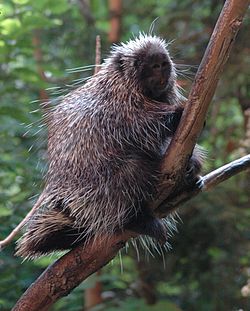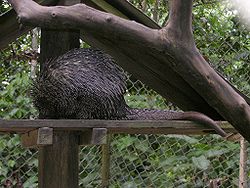List of erethizontids

Erethizontidae is a family of mammals in the order Rodentia and part of the Caviomorpha parvorder. Members of this family are called erethizontids or New World porcupines. They are found in North America, Central America, and South America, primarily in forests, though some species can be found in shrublands, grasslands, and savannas. They range in size from the Paraguaian hairy dwarf porcupine, at 24 cm (9 in) plus a 9 cm (4 in) tail, to the North American porcupine, at 130 cm (51 in) plus a 25 cm (10 in) tail. Erethizontids are herbivores and primarily eat leaves, stems, fruit, blossoms, and roots. No erethizontids have population estimates, and none are categorized as an endangered species or critically endangered.
The eighteen extant species of Erethizontidae are divided into two subfamilies: Chaetomyinae consists of a single species, the bristle-spined rat, and Erethizontinae contains seventeen species of porcupines in two genera. A few extinct prehistoric erethizontid species have been discovered, though due to ongoing research and discoveries, the exact number and categorization is not fixed.[1]
Conventions
[edit]| Conservation status | |
|---|---|
| EX | Extinct (0 species) |
| EW | Extinct in the wild (0 species) |
| CR | Critically endangered (0 species) |
| EN | Endangered (0 species) |
| VU | Vulnerable (2 species) |
| NT | Near threatened (0 species) |
| LC | Least concern (9 species) |
| Other categories | |
| DD | Data deficient (6 species) |
| NE | Not evaluated (1 species) |
Conservation status codes listed follow the International Union for Conservation of Nature (IUCN) Red List of Threatened Species. Range maps are provided wherever possible; if a range map is not available, a description of the erethizontid's range is provided. Ranges are based on the IUCN Red List for that species unless otherwise noted.
Classification
[edit]Erethizontidae is a family consisting of eighteen species in three genera, divided between two subfamilies. Chaetomyinae consists of a single species, and Erethizontinae contains seventeen species of porcupines in two genera.
- Family Erethizontidae
- Subfamily Chaetomyinae
- Genus Chaetomys (bristle-spined rat): one species
- Subfamily Erethizontinae
- Subfamily Chaetomyinae
Erethizontids
[edit]The following classification is based on the taxonomy described by the reference work Mammal Species of the World (2005), with augmentation by generally accepted proposals made since using molecular phylogenetic analysis, as supported by both the IUCN and the American Society of Mammalogists.[2]
Subfamily Chaetomyinae
[edit]| Common name | Scientific name and subspecies | Range | Size and ecology | IUCN status and estimated population |
|---|---|---|---|---|
| Bristle-spined rat | C. subspinosus (Olfers, 1818) |
Eastern Brazil
|
Size: 36–45 cm (14–18 in) long, plus 26–27 cm (10–11 in) tail[3] Habitat: Forest[4] Diet: Nuts[5] |
VU
|
Subfamily Erethizontinae
[edit]| Common name | Scientific name and subspecies | Range | Size and ecology | IUCN status and estimated population |
|---|---|---|---|---|
| Andean porcupine | C. quichua Thomas, 1899 |
Panama and northeastern South America | Size: 33–44 cm (13–17 in) long, plus 26–41 cm (10–16 in) tail[6] Habitat: Forest[7] Diet: Leaves, stems, fruit, blossoms, and roots[8] |
DD
|
| Bahia porcupine | C. insidiosus (Olfers, 1818) |
Eastern Brazil | Size: 29–35 cm (11–14 in) long, plus 18–22 cm (7–9 in) tail[3] Habitat: Forest[9] Diet: Leaves, stems, fruit, blossoms, and roots[8] |
LC
|
| Baturite porcupine | C. baturitensis Feijó & Langguth, 2013 |
Northeastern Brazil | Size: 46–55 cm (18–22 in) long, plus 32–47 cm (13–19 in) tail[3] Habitat: Forest[10] Diet: Leaves, stems, fruit, blossoms, and roots[8] |
DD
|
| Bicolored-spined porcupine | C. bicolor (Tschudi, 1844) Four subspecies
|
Western and northwestern South America
|
Size: 38–50 cm (15–20 in) long, plus 33–54 cm (13–21 in) tail[6] Habitat: Forest[11] Diet: Leaves, stems, fruit, blossoms, and roots[8] |
LC
|
| Black dwarf porcupine | C. nycthemera (Olfers, 1818) |
Northern Brazil
|
Size: 29–38 cm (11–15 in) long, plus 28–37 cm (11–15 in) tail[6] Habitat: Forest[12] Diet: Leaves, stems, fruit, blossoms, and roots[8] |
DD
|
| Black-tailed hairy dwarf porcupine | C. melanurus (Wagner, 1842) |
Northern South America | Size: 28–38 cm (11–15 in) long, plus 22–36 cm (9–14 in) tail[6] Habitat: Forest[13] Diet: Leaves, stems, fruit, blossoms, and roots[8] |
LC
|
| Brazilian porcupine | C. prehensilis (Linnaeus, 1758) |
South America
|
Size: 29–48 cm (11–19 in) long, plus 31–43 cm (12–17 in) tail[3] Habitat: Forest[14] Diet: Leaves, stems, fruit, blossoms, and roots[8] |
LC
|
| Brown hairy dwarf porcupine | C. vestitus Thomas, 1899 |
Central Colombia | Size: 29–37 cm (11–15 in) long, plus 17–19 cm (7–7 in) tail[6] Habitat: Forest[15] Diet: Leaves, stems, fruit, blossoms, and roots[8] |
DD
|
| Dwarf porcupine | C. speratus Pontes, Gadelha, Melo, de Sá, Loss, Caldara Jr., Costa, & Leite, 2013 |
Eastern Brazil | Size: 33–44 cm (13–17 in) long, plus 29–32 cm (11–13 in) tail[6] Habitat: Forest[16] Diet: Leaves, stems, fruit, blossoms, and roots[8] |
VU
|
| Frosted hairy dwarf porcupine
|
C. pruinosus Thomas, 1905 |
Colombia and Venezuela | Size: 32–38 cm (13–15 in) long, plus about 19 cm (7 in) tail[6] Habitat: Forest[17] Diet: Leaves, stems, fruit, blossoms, and roots[8] |
LC
|
| Mexican hairy dwarf porcupine | C. mexicanus (Kerr, 1792) |
Mexico and Central America
|
Size: 35–46 cm (14–18 in) long, plus 20–36 cm (8–14 in) tail[3] Habitat: Forest[18] Diet: Leaves, stems, fruit, blossoms, and roots[8] |
LC
|
| Paraguaian hairy dwarf porcupine | C. spinosus (Cuvier, 1822) |
Southeastern South America | Size: 24–55 cm (9–22 in) long, plus 20–38 cm (8–15 in) tail[6] Habitat: Forest and savanna[19] Diet: Leaves, stems, fruit, blossoms, and roots[8] |
LC
|
| Roosmalen's dwarf porcupine
|
C. roosmalenorum Voss & da Silva, 2001 |
Western Brazil | Size: About 29 cm (11 in) long, plus about 26 cm (10 in) tail[6] Habitat: Forest[20] Diet: Leaves, stems, fruit, blossoms, and roots[8] |
DD
|
| Rothschild's porcupine | C. rothschildi Thomas, 1902 |
Panama
|
Size: 33–44 cm (13–17 in) long, plus 26–41 cm (10–16 in) tail[6] Habitat: Forest[7] Diet: Leaves, stems, fruit, blossoms, and roots[8] |
NE
|
| Streaked dwarf porcupine
|
C. ichillus Voss & da Silva, 2001 |
Eastern Ecuador
|
Size: 26–29 cm (10–11 in) long, plus 21–25 cm (8–10 in) tail[6] Habitat: Forest[21] Diet: Leaves, stems, fruit, blossoms, and roots[8] |
DD
|
| Stump-tailed porcupine | C. rufescens (J. E. Gray, 1865) |
Northwestern and central South America | Size: 31–37 cm (12–15 in) long, plus 10–15 cm (4–6 in) tail[3] Habitat: Forest[22] Diet: Leaves, stems, fruit, blossoms, and roots[8] |
LC
|
| Common name | Scientific name and subspecies | Range | Size and ecology | IUCN status and estimated population |
|---|---|---|---|---|
| North American porcupine | E. dorsatum (Linnaeus, 1758) Seven subspecies
|
North America
|
Size: 60–130 cm (24–51 in) long, plus 16–25 cm (6–10 in) tail[3] Habitat: Forest, shrubland, and grassland[23] Diet: Buds, twigs, roots, stems, leaves, flowers, seeds, berries, nuts, and other vegetation[24] |
LC
|
References
[edit]- ^ "Fossilworks: Erethizontidae". Paleobiology Database. University of Wisconsin–Madison. Archived from the original on January 23, 2025. Retrieved June 7, 2025.
- ^ Wilson, Reeder, pp. 1545-1549
- ^ a b c d e f g Chernasky; Motis; Burgin, p. 353
- ^ a b Catzeflis, F.; Patton, J.; Percequillo, A.; Bonvicino, C. R.; Weksler, M. (2017). "Chaetomys subspinosus". IUCN Red List of Threatened Species. 2017: e.T4366A22213335. doi:10.2305/IUCN.UK.2017-2.RLTS.T4366A22213335.en.
- ^ Nowak, p. 1701
- ^ a b c d e f g h i j k Chernasky; Motis; Burgin, p. 354
- ^ a b c d Delgado, C. (2016). "Coendou quichua". IUCN Red List of Threatened Species. 2016: e.T136702A22214415. doi:10.2305/IUCN.UK.2016-2.RLTS.T136702A22214415.en.
- ^ a b c d e f g h i j k l m n o p Nowak, pp. 1654–1656
- ^ a b Roach, N.; Naylor, L. (2016). "Coendou insidiosus". IUCN Red List of Threatened Species. 2016: e.T20631A22213745. doi:10.2305/IUCN.UK.2016-2.RLTS.T20631A22213745.en.
- ^ a b Roach, N. (2016). "Coendou baturitensis". IUCN Red List of Threatened Species. 2016: e.T87411473A87411477. doi:10.2305/IUCN.UK.2016-2.RLTS.T87411473A87411477.en.
- ^ a b Delgado, C. (2016). "Coendou bicolor". IUCN Red List of Threatened Species. 2016: e.T5083A22214310. doi:10.2305/IUCN.UK.2016-2.RLTS.T5083A22214310.en.
- ^ a b Delgado, C. (2016). "Coendou nycthemera". IUCN Red List of Threatened Species. 2016: e.T5084A22214228. doi:10.2305/IUCN.UK.2016-2.RLTS.T5084A22214228.en.
- ^ a b Catzeflis, F. . (2016). "Coendou melanurus". IUCN Red List of Threatened Species. 2016: e.T136738A22213900. doi:10.2305/IUCN.UK.2016-2.RLTS.T136738A22213900.en.
- ^ a b Marinho-Filho, J.; Emmons, L. (2016). "Coendou prehensilis". IUCN Red List of Threatened Species. 2016: e.T101228458A22214580. doi:10.2305/IUCN.UK.2016-2.RLTS.T101228458A22214580.en.
- ^ a b Weksler, M.; Anderson, R. P.; Gómez-Laverde, M. (2016). "Coendou vestitus". IUCN Red List of Threatened Species. 2016: e.T20633A22213528. doi:10.2305/IUCN.UK.2016-2.RLTS.T20633A22213528.en.
- ^ a b Hurtado Materon, M. A.; Mendes Pontes, A. R.; Torres-Martinez, M. M.; Lawing, M. (2024). "Coendou speratus". IUCN Red List of Threatened Species. 2024: e.T46205559A259146246. doi:10.2305/IUCN.UK.2024-2.RLTS.T46205559A259146246.en.
- ^ a b Delgado, C. . (2016). "Coendou pruinosus". IUCN Red List of Threatened Species. 2016: e.T136485A22213797. doi:10.2305/IUCN.UK.2016-2.RLTS.T136485A22213797.en.
- ^ a b Vázquez, E.; Reid, F.; Cuarón, A. D. (2016). "Coendou mexicanus". IUCN Red List of Threatened Species. 2016: e.T20629A22214103. doi:10.2305/IUCN.UK.2016-2.RLTS.T20629A22214103.en.
- ^ a b Roach, N.; Naylor, L. (2016). "Coendou spinosus". IUCN Red List of Threatened Species. 2016: e.T20630A22213974. doi:10.2305/IUCN.UK.2016-2.RLTS.T20630A22213974.en.
- ^ a b Roach, N.; Naylor, L. (2016). "Coendou roosmalenorum". IUCN Red List of Threatened Species. 2016: e.T136518A22214051. doi:10.2305/IUCN.UK.2016-2.RLTS.T136518A22214051.en.
- ^ a b Weksler, M.; Anderson, R. P.; Gómez-Laverde, M. (2016). "Coendou ichillus". IUCN Red List of Threatened Species. 2016: e.T136597A22213629. doi:10.2305/IUCN.UK.2016-2.RLTS.T136597A22213629.en.
- ^ a b Tirira, D. (2016). "Coendou rufescens". IUCN Red List of Threatened Species. 2016: e.T7010A22213241. doi:10.2305/IUCN.UK.2016-2.RLTS.T7010A22213241.en.
- ^ a b Emmons, L. (2016). "Erethizon dorsatum". IUCN Red List of Threatened Species. 2016: e.T8004A22213161. doi:10.2305/IUCN.UK.2016-3.RLTS.T8004A22213161.en.
- ^ Nowak, p. 1658
Sources
[edit]- Chernasky, Amy; Motis, Anna; Burgin, Connor, eds. (2023). All the Mammals of the World. Lynx Nature Books. ISBN 978-84-16728-66-4.
- Nowak, Ronald M. (1999). Walker's Mammals of the World. Vol. 2 (6th ed.). Johns Hopkins University Press. ISBN 978-0-8018-5789-8.
- Woods, Charles A.; Kilpatrick, C. William (2005). Wilson, Don E.; Reeder, DeeAnn M. (eds.). Mammal Species of the World. Vol. 2 (3rd ed.). Johns Hopkins University Press. ISBN 978-0-8018-8221-0.













